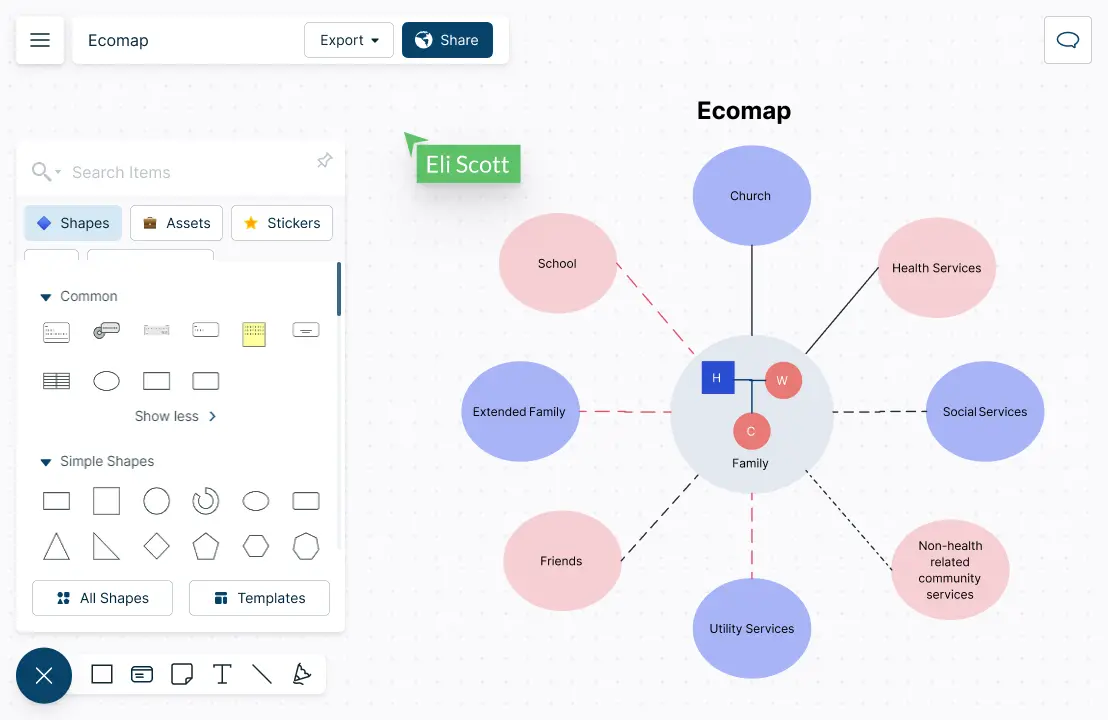









Quickly start mapping your client’s family ecological system with pre-made ecomap templates. Understand the family dynamics and their connection to the community better.
 your research data" width="644" height="419" />
your research data" width="644" height="419" />
Link information for easy analysis by embedding all information, including documents, records, and assets, under one workspace or in the infinite canvas. Organize the gathered data in workspaces and folders for quick access and sorting.
 your research data" width="644" height="419" />
your research data" width="644" height="419" />


Assess the family, social, and community relationships by creating ecomaps using the extensive shape library and dynamic connectors. Convert ecomap findings to family trees, genograms, and hierarchical charts to create different perspectives.

Discuss and analyze relationships with colleagues, family members, clients, and peer researchers on one shared canvas with synced previews and live mouse tracking. Use contextual comments to share feedback.

Ecomaps (or eco maps) are helpful, especially in assessing family, social, and community relationships. It is a visual map that shows an individual’s or a family’s connection to the external world. Employed mainly by social workers, it is a great way to get a clear and detailed picture of a client’s social and family relationships. By mapping the dynamics of these relationships, one can try to see if any disconnections or concerns lead to an unhealthy family life. Other advantages of using an ecomap include:
However, the usage of ecomaps is now no longer limited to social workers. It is used in various disciplines to understand an ecosystem, how an individual interacts with an ecosystem, resource availability, client or community requirements, and much more.
There are many ecomap examples and templates that can be used depending on the situation and your requirement. The most common types of ecomap templates are:
More specific templates include,
Ecomaps can be used in a collaborative setting, involving the individuals or family members themselves, to gather information and gain insights into their strengths, challenges, and relationships more effectively.
Here’s how you can use ecomaps collaboratively:
Focus on the underlying assumptions and beliefs that shape the design and plan for a program. These models offer a comprehensive explanation of the rationale behind the initiation of a particular program idea.
While an ecomap template visualizes the challenges and strengths within a family or group, it help encourage discussion around potential solutions to the problems as well. This way you can easily identify the resources and support systems needed to address the needs of the individuals.
The ecomap template is a useful decision-making tool, as it helps individuals to consider different options and their potential impact on the relationships and systems represented in the map.
Ecomaps can help reduce conflict and promote cooperatio among family members by building consensus and understanding among them.
To start visualizing your ecomap, first create a key or guide of the symbols that you will be using. The types of symbols will vary depending on the complexity of your needs.
List down the name of the individual in the center of the circle. If you are creating a family ecomap, create a genogram in the center of the circle to represent the family. Represent males and females using squares and circles, respectively. Also, make sure to put each person’s name and age in the representative shapes. Before moving to the next step, draw a bigger circle surrounding the circle in the center.
If you don’t know where to start visualizing, the best is to start with a premade ecomap template. Customize the template the way you want using the shape library, dynamic connectors, and advanced formatting options. Creately provides access to a host of templates to get you started quickly.
Draw more circles to identify the social and environmental systems that impact the individual/family. Include extended family, friendships, relevant people, and community. Next, identify extended relationships and friendships beyond the immediate family and connections. Also, don’t forget to include some more circles for institutions, entities, and other possible associations such as schools, work, religious places, government agencies (i.e., child care protection services), welfare programs/agencies, etc. Use different colors to differentiate.
Use Plus Create to draw shapes automatically. Select from the preset colors by hovering over the shape or from the extensive color options available in the shape properties panel. Format the shapes and align the text the way you want. Add hyperlinks from outside sources if required.
Draw connecting lines between the individual/family to the external entities. Use the key you first established to determine the quality of the relationship and the type of connector. Arrowheads should be added to show direction.
Use dynamic connectors that arrange themselves automatically to easily connect shapes and show relationships.
Always remember to date your ecomap. Share with colleagues for feedback. Define access and role levels to streamline, share, review and edit the ecomap. Use real-time cursors for any number of participants to work on the ecomap at the same time. Have discussions and provide feedback with comments with context.
Export the ecomap as SVG, PNG, JPEG, and PDFs to publish, present, print, or share.